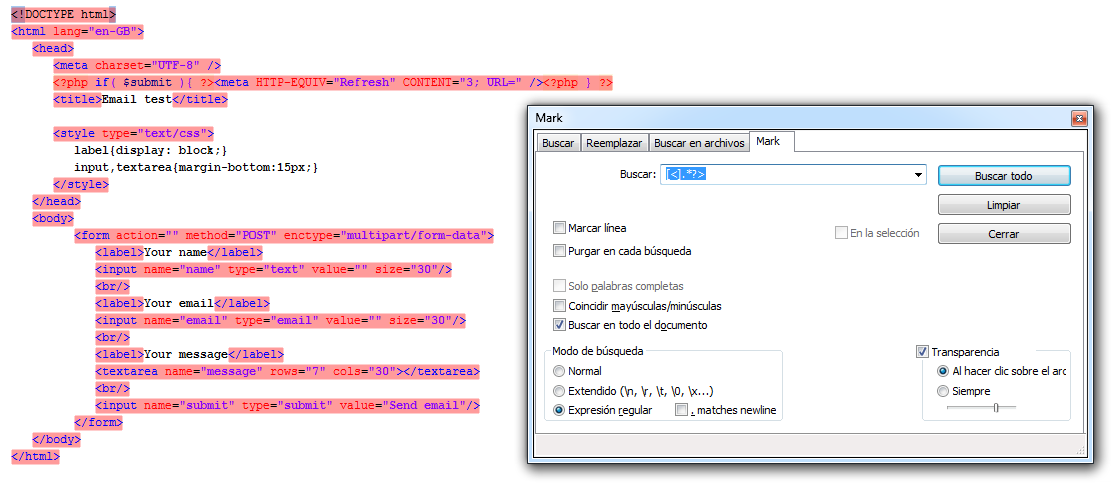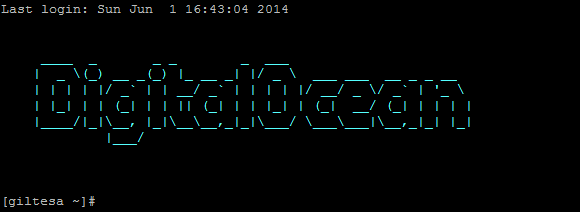|
1 |
[<].*?> |
Categoría: Informatica
Mensaje de bienvenida en CentOS/Linux
Se hace editado el fichero /etc/motd
|
1 |
nano /etc/motd |
El contenido, normalmente, es texto plano y se mostrara en el inicio de sesión. Se puede poner texto o caracteres ASCII para mostrar texto en grande o dibujos:
|
1 2 3 4 5 |
_ _ _ | | | | ___ | | __ _ | |_| |/ _ \| |/ _` | | _ | (_) | | (_| | |_| |_|\___/|_|\__,_| |
También se pueden añadir colores mediante caracteres no legibles. Aunque no he sabido como insertarlos desde el Notepad++, así que hace falta usar los comandos:
|
1 2 3 4 5 6 7 |
echo -en "\033[1;36m" > /etc/motd echo -en "\r\n" >> /etc/motd echo "...Mensaje de bienvenida..." >> /etc/motd echo -en "\033[0m" >> /etc/motd echo -en "\r\n\r\n" >> /etc/motd |
Después se puede sustituir el texto por otro pero sin borrar los caracteres especiales, quedando así:
Viene bien cuando se mantiene varios servidores, así se diferencian al menos al iniciar sesión, aunque también se podría cambiar el color del fondo o el del texto (sin necesidad de tocar el cliente)
Más info:
http://www.bdunk.com/motd-linux
Edit:
Listado de colores:
http://midactstech.blogspot.com/2013/11/how-to-add-color-to-your-motd.html
|
1 2 3 4 5 6 7 8 9 10 11 12 13 14 15 16 17 18 |
# Text Color Variables BLK="\033[00;30m" # BLACK R="\033[00;31m" # RED GRN="\033[00;32m" # GREEN BR="\033[00;33m" # BROWN BL="\033[00;34m" # BLUW P="\033[00;35m" # PURPLE C="\033[00;36m" # CYAN LtG="\033[00;37m" # LIGHT GRAY DkG="\033[01;30m" # DARK GRAY LtR="\033[01;31m" # LIGHT RED LtGRN="\033[01;32m" # LIGHT GREEN Y="\033[01;33m" # YELLOW LtBL="\033[01;34m" # LIGHT BLUE LtP="\033[01;35m" # LIGHT PURPLE LtC="\033[01;36m" # LIGHT CYAN W="\033[01;37m" # WHITE |
Formulario PHP para enviar Emails
|
1 2 3 4 5 6 7 8 9 10 11 12 13 14 15 16 17 18 19 20 21 22 23 24 25 26 27 28 29 30 31 32 33 34 35 36 37 38 39 40 41 42 43 44 45 46 47 48 49 50 51 52 53 54 55 56 57 |
<?php $submit = !empty($_REQUEST['submit']); ?> <!DOCTYPE html> <html lang="en-GB"> <head> <meta charset="UTF-8" /> <?php if( $submit ){ ?><meta HTTP-EQUIV="Refresh" CONTENT="3; URL=" /><?php } ?> <title>Email test</title> <style type="text/css"> label{display: block;} input,textarea{margin-bottom:15px;} </style> </head> <body> <?php // Display the contact form: if( !$submit ) { ?> <form action="" method="POST" enctype="multipart/form-data"> <label>Your name</label> <input name="name" type="text" value="" size="30"/> <br/> <label>Your email</label> <input name="email" type="email" value="" size="30"/> <br/> <label>Your message</label> <textarea name="message" rows="7" cols="30"></textarea> <br/> <input name="submit" type="submit" value="Send email"/> </form> <?php } // Send the submitted data: else { $name = $_REQUEST['name']; $email = $_REQUEST['email']; $message = $_REQUEST['message']; if( empty($name) || empty($email) || empty($message) ) { ?><p>All fields are required.<br/>You will be redirected in 3 seconds.</p><?php } else { $from = "From: $name<$email>\r\nReturn-path: $email"; $subject = "Message sent using your contact form"; mail( $email/*TO*/, $subject, $message, $from ) ; ?><p>Email sent!<br/>You will be redirected in 3 seconds.</p><?php } } ?> </body> </html> |
Edit:
El visualizado de código de WP omite algunas partes del código PHP por seguridad. Desde aquí puede bajarse el fichero original:
[Java] Ordenar lista de objetos al azar
|
1 2 3 4 5 6 7 8 9 10 11 12 13 14 15 16 17 18 19 20 21 22 |
private static List< Shop > randomSort(List< Shop > inList) { int numItems = inList.size(); List< Shop > outList = new ArrayList< Shop >(); Integer[] randomNumbers = new Integer[numItems]; int itm = 0; int cm = 0; while( cm < numItems ) { itm = new Double(Math.random() * numItems).intValue(); if( randomNumbers[itm] == null ) { randomNumbers[itm] = cm++; } } for( int i = 0 ; i < numItems ; i++ ) outList.add(inList.get(randomNumbers[i])); return outList; } |
Copia y restaura base de datos mediante comandos
|
1 2 3 4 5 |
#Copia: mysqldump --opt --user=USUARIO --password='CONTRASEÑA' NOMBRE_DB > NOMBRE_FICHERO.sql; #Restaura: mysql --user=USUARIO --password='CONTRASEÑA' NOMBRE_DB < NOMBRE_FICHERO.sql |
Omitir la introducción de la contraseña al inicio de sesión de Windows
Pulsar: windows+r
Escribir: control userpasswords2
Desmarcar: Los usuarios deben escribir su nombre y contraseña para usar el equipo.
Aceptar.
Fuente:
http://www.ehowenespanol.com/omitir-inicio-sesion-windows-xp-como_295309/

